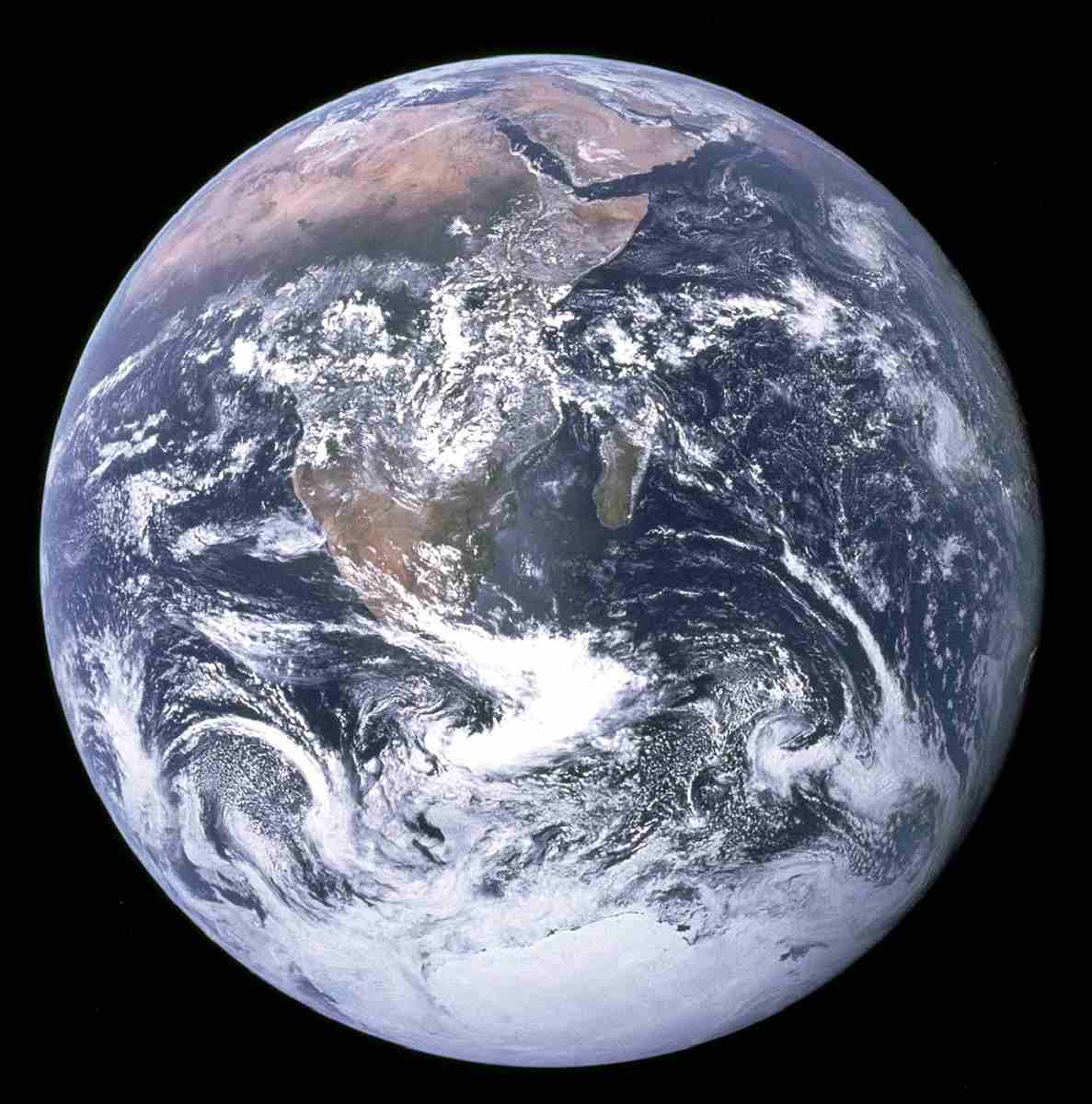
Earth is seen by the Apollo 17 crew traveling toward the moon on Dec. 7, 1972.
17:53 JST, November 23, 2023
WASHINGTON (Reuters) — Seismologists have recognized since the 1970s that two mysterious continent-sized blobs reside in the deepest part of Earth’s mantle, one under Africa and the other under the South Pacific region.
These blobs, denser than the material surrounding them, may be relics from a cataclysm early in our planet’s history hypothesized to have spawned the moon — the collision between primordial Earth and a Mars-sized object called Theia, researchers said on Nov. 1.
This giant impact, which recent research determined occurred more than 4.46 billion years ago, blasted molten rock into space that orbited Earth and coalesced into the moon. But chunks of Theia may have remained inside Earth, sinking to a location just above our planet’s wickedly hot spherical core of iron and nickel.
The researchers ran computer simulations examining the impact event, geophysical properties of the material that likely made up Theia and the evolution of Earth’s mantle — the broadest of the layers that comprise our planet’s interior structure at about 2,900 kilometers thick.
Based on these simulations, they proposed that most of Theia was absorbed into Earth, forming the blobs, while residual debris formed the moon.
“The bottoms of these blobs are 2,900 kilometers below our feet. The two blobs are about 2% of Earth’s mass. They were detected by seismology as seismic waves travel slower within these two regions compared to the surrounding mantle. Each of the blobs are twice the mass of the whole moon. So, the blobs are massive,” said Caltech geophysicist Qian Yuan, lead author of the study published in the journal Nature.
If the study’s conclusions are correct, these blobs would represent elusive evidence right here on Earth of the hypothesized moon-forming collision.
“There hasn’t been much consensus on whether we can find evidence for this event not just in the moon but also in some observable property of the modern Earth,” Caltech geology and geochemistry professor and study coauthor Paul Asimow said.
The two blobs, Asimow added, “are the biggest deviations in Earth’s structure from a simple layered planet.”
“It is incredible because we can uncover relics of another planet — Theia — if we dig deep enough in Earth’s mantle,” added planetary scientist and study coauthor Hongping Deng of the Chinese Academy of Sciences’ Shanghai Astronomical Observatory.
The increased density of the blobs is thought to arise from their high level of iron — much like moon rocks, which would make sense if they are made of the same source material from Theia.
“After the impact, these impactor materials would sink down to the core-mantle boundary because they likely have higher density than ambient mantle, and it is the extra density that allows them to survive Earth’s whole history,” Yuan said.
The moon, which orbits Earth at an average distance of about 385,000 kilometers, has a diameter of about 3,475 kilometers, a bit more than a quarter of our planet’s diameter.
Asimow said that if their conclusions are correct, some volcanic rocks that reach Earth’s surface may provide samples of a vanished planet.
“If our model is correct, the blobs should have isotopes — trace elements — that are similar to the lunar mantle rocks, which can be tested in future lunar missions,” Yuan said.
Gaining a greater understanding of the hypothesized giant impact may provide insight concerning the evolution of Earth and other rocky planets in our solar system and beyond.
“Earth is still the only confirmed habitable planet, and we do not know why,” Yuan said. “This collision likely set the initial condition of Earth’s evolution. Studying its consequences may help us to figure out why Earth is different than other rocky planets.”
"Science & Nature" POPULAR ARTICLE
-

Mass Oyster Die-Offs Confirmed in Japan’s Seto Inland Sea; High Water Temperature Cited as Primary Cause
-

Genome Study Reveals Milestone in History of Cat Domestication
-

Big Leap in Quest to Get to Bottom of Climate Ice Mystery
-

Security Camera Footage Vulnerable to Outside Access; Investigation Finds 3,000 Pieces Exposed Online
-

Paws on Parade: Nairobi’s Dogs Dazzle at ‘Pawchella’
JN ACCESS RANKING
-

Keidanren Chairman Yoshinobu Tsutsui Visits Kashiwazaki-Kariwa Nuclear Power Plant; Inspects New Emergency Safety System
-

Imports of Rare Earths from China Facing Delays, May Be Caused by Deterioration of Japan-China Relations
-

University of Tokyo Professor Discusses Japanese Economic Security in Interview Ahead of Forum
-

Japan Pulls out of Vietnam Nuclear Project, Complicating Hanoi’s Power Plans
-

Govt Aims to Expand NISA Program Lineup, Abolish Age Restriction


























